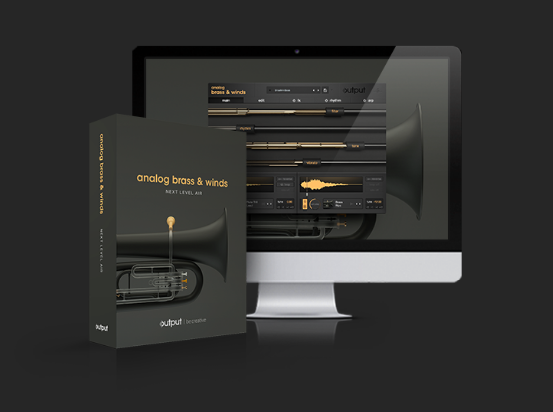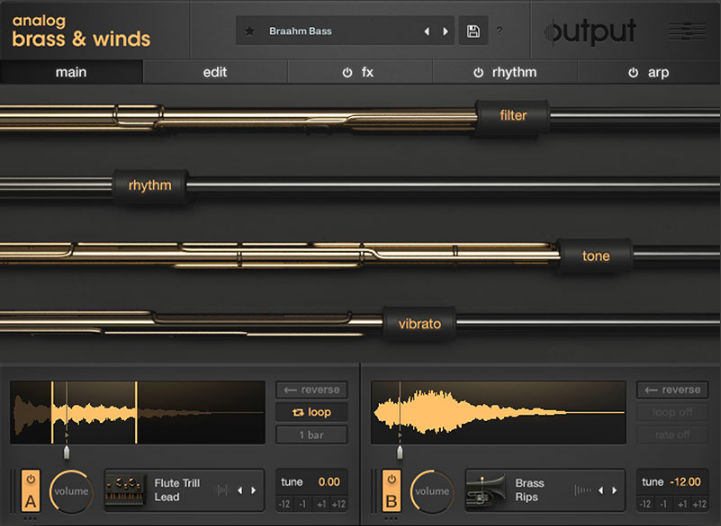New Software Review: Analog Brass & Winds by Output

With Analog Brass & Winds, Output has gone to great lengths to design their most in-depth and versatile virtual instrument to date.
With the vast amount of virtual instruments available today, trying to find one that stands out and offers something new can feel daunting. But over the past few years, Output has continuously delivered some of the most creative and intriguing VIs on the market.
After their success with Analog Strings, Output’s user base requested that they re-imagine the sounds of brass and wind instruments. Output accepted this challenge head-on, and the result is Analog Brass & Winds.
Analog Brass & Winds (ABW) is Output’s most robust and feature-filled instrument to date. The level of depth available makes for an instrument that has wonderful harmonic qualities, and Output presents it in a unique and non-traditional way.
ABW was designed to appeal to a wide audience, including beat-makers, producers, sound designers, and film/video composers. While a sizable amount of ABW’s sonic qualities might most appeal to those creating soundscapes and scores, there are also lots of patches that lend themselves well to contemporary music productions. Let’s take a deeper look at Analog Brass & Winds.
Features
Output continuously finds ways to push the boundaries of what can be done inside Native Instruments’ Kontakt engine, and these achievements are clear within the first few minutes of exploring ABW. Requiring about 17GB of space, ABW packs around 500 patches that range from mangled EDM leads to lush pads, as well as sounds that would fit perfectly into the score of an episode of Stranger Things.
The value of any Kontakt instrument is largely determined by the quality of the samples it uses, and here Output has delivered. The included samples range from numerous vintage analog synths all the way to live musicians of today.
The analog synths in ABW were meticulously sampled by Output, while the live samples were recorded at BMC Hall in Budapest by an 18-piece brass section, an 18-piece woodwind section, and select soloists who performed using traditional and non-traditional techniques. All the samples are organized as One-shots, Pads, or Tape, and then subcategorized as Orchestral, Synth, and Creative.
Every patch in ABW is made up of two sound sources that are blended together. You can edit and control each source independently, or opt to turn one off. This allows for some incredible combinations of sounds, and is similar in this regard to other instruments like Spectrasonics’ Omnisphere and Spitfire Audio’s eDNA. (See my review of eDNA on SonicScoop here.)
When you load up ABW in the Kontakt library, you’re given access to the patch list and 4 quick-access macros that are assignable in every patch. From there, you can scroll through the patch library or dive into the editing features of the selected patch.
It’s the editing and deep control of ABW that brings this instrument to life; there are lots of ways to tailor the sound inside each instrument. Editing controls are broken down into 4 sections with separate controls for the two sound sources.
The first section is “Edit,” which has amplitude and pitch envelopes, as well as mono/poly controls. The FX section contains individual effects for the sound sources, as well as a Global Effects section that processes the combined sound. The available effects include multiple filters, a 3-band parametric EQ, distortion/lo-fi, compression, delay, and reverb. Inside the Global Effects section is an additional effect called “Motion,” which contains phaser- and chorus-style effects.
The next two editing tabs in ABW are rhythm-based, and they are a big reason that this instrument is so inspiring to use. These two engines allow for an unbelievable amount of tonal and rhythmic possibilities, and it’s all too easy to get lost in time as you experiment with all the combinations.
The first section is the “Rhythm” section, which allows you to assign two rhythmically-timed generators per sound source. The generators can be assigned to volume, panning, filter cutoff and resonance, and the levels of gain for the multiple distortion effects in the instrument. Each generator can be set to a wave shape or a step sequencer pattern. The feature essentially acts like the LFO section on a traditional synth, except that it feels far more robust and refined.
The selectable time divisions go from 8 bars to 64th notes. If you choose to use a wave shape, there are 24 distinct shapes to choose from. Using the step sequencer, you can choose from a range of 1 to 32 steps with additional controls for smoothing and randomization.
As if having 4 different time-based modulators wasn’t enough to fulfill your desires, Output took it a step farther by including a “Flux” option for each generator. Inside the flux option is what Output has labeled a “Flux Rate Sequencer”. This allows you to create up to an 8-step sequence of rhythmic subdivisions for the selected generator. Each step can be triggered up to 16 times.
Output was also generous enough to show you the total number of beats your sequence will take up, which saves you a bit of math when creating more complex patterns. In practice, this means that instead of having one of the generators set to only 8th notes, it could play four 8th notes, two quarter notes, eight 16th notes, and so on. The combinations of potential rhythms are incredibly vast. Once you’ve created a rhythm, you can also save it as a rhythmic preset.
The final section of Analog Brass & Winds is the arpeggiator, which ranges from 1 to 32 steps. Each sound source is assigned its own arpeggiator, and you can choose to engage one and not the other. There are various modes to choose from, including Chordal, Up, Down, Random, and Zig-zag. You can also assign a top or low note pedal to be played in between every other note. This instantly gives the arpeggiator a neoclassical sound. There is a solid selection of preset patterns, or you can write in your own.
Additionally, you can control the note length of the pattern, how many octaves are used, and adjust the “swing” amount. This arpeggiator is full-featured, and integrates well with the rhythm controls on the previous page.
In Use
It’s no doubt that Output has created a standout product with Analog Brass & Winds. Just as Spitfire Audio used eDNA Earth to take a collection of largely human-created organic sounds to make an “evolved” synthesized sound, Output has rivaled their innovation with ABW. Unlike eDNA’s attempt to cover a wide spectrum of sounds, ABW is far more focused, and this benefits the overall design greatly.
There’s an undeniable “retro” quality to many of the patches, yet it all feels remarkably new at the same time. Many of the sounds in ABW feel like they are constantly evolving, and there’s a sense of air and space in nearly every tone; nothing feels cold and artificial. With so much of today’s music relying on the use of samples, having instruments that create an added level of depth goes a long way in keeping a mix feeling fresh and interesting to our ears.

Reminiscent of other Output designs, ABW’s GUI offers a series of horizontal sliders that enable you to customize your tone and performance with great detail.
Navigating ABW’s GUI is a breeze, and all the parameters are easy to access. It’s intuitive for you to understand how to manipulate a patch, and there’s a very minimal learning curve. Output has done a good job in making ABW feature-packed while not over-saturating it with too many options that would take away from the overall experience.
For instance, the parameters within each effect (reverb, distortion, delay, etc.) often feature just two to three knobs, and are very straightforward. Saving presets and rhythms that you create within the rhythm generators is simple, and ABW allows you to recall creative patterns and apply them to other patches with ease.
The rhythmic sections of ABW are where you are likely to spend most of your time exploring, and the results can be extremely fun and rewarding. Creating complex and evolving patterns can dramatically enhance an arpeggiating sound. You can also create wild polyrhythmic patterns between the two sound sources. I particularly enjoyed creating duplet/triplet patterns like 3:2 (three 8th note triplets against two regular 8th notes). The relatively small file size of the individual patches also means these full and lush sounds won’t tax your CPU or RAM too heavily.
To Be Critical
Output has created a brilliant-sounding instrument with Analog Brass & Winds, and there’s very little to dislike about the user experience and overall quality. Software companies like Output always seem to push the boundaries of what a Kontakt instrument can be, but they are still bound by the inherent restrictions of the Kontakt platform. This can inevitably lead to some challenges.
For users that have a deep knowledge of Kontakt itself, some of these hurdles can be overcome by going into Kontakt’s editor and seeking out the solutions. For other users, looking under the hood of a Kontakt instrument can be an intimidating and scary experience.
An example of this would be seeking to change the pitch bend range of the instrument. By default, pitch bend is set to one step up/down. The only way to change this is to go under the hood and work with the group editor. Although this is far from an insurmountable challenge, it’s still a challenge nonetheless.
While the sounds available in ABW cover numerous styles of music, to my ears, of the majority of the patches lend themselves more to the worlds of soundscape and scoring. There are a lot of great polysynth patches, brooding pads, and edgy leads, but there are even more patches that are reminiscent of scenes from a 1980s horror movie, dark thrillers, distant sci-fi planets, and whimsical dreamscapes.
Output has implemented a search filter into their patch list, which is designed to make it easier to narrow down the kind of sounds you are after. With nearly 500 patches, this should be an extremely useful tool, however, I found that oftentimes the filter produced mixed results.
Choose to only show pads, and the seventh patch on the list is entitled “Hell Bent Lead”—a sharp cutting mono synth patch which does not resemble a pad. Select “Solo,” which one would assume would only show you mono synths, and most of the patches are polyphonic. (Surprisingly, you won’t see “Hell Bent Lead” here, which is a mono synth.)
Given that the sounds cover so much ground stylistically, it might be beneficial to offer filtering based on genre. I’ve found that search filters like this are always subjective, but it would be great to have a few choices, such as Cinematic, EDM, and Pop, for example.
Summing it Up
Analog Brass & Winds by Output is an inspiring and powerful Kontakt instrument. At a price of $199, ABW includes a deep collection of distinct sounds that range from dark to beautiful; from amazingly organic to wild and absurd. The focus of the instrument is clear, and it will likely occupy a unique spot in your library of virtual instruments. Due to its one-of-a-kind sound, you’ll know exactly when a project calls for ABW—and also when it doesn’t. The powerful rhythmic section will make you wish you had this degree of control in many of your other VIs, and it’s exciting to imagine how far Output will take this element in the future.
For those who work in the scoring world, I would argue that ABW is almost a must-have; you’ll find countless uses for its sounds. For others who aim to bring something new to their music, or those searching for sounds that don’t feel tired and overused, ABW is sure to deliver exciting new results.
Please note: When you buy products through links on this page, we may earn an affiliate commission.






